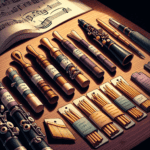Introduction to Clarinet Reed Placement
Welcome to the world of clarinet playing! We all know that a good reed makes all the difference. But don't just take my word for it—let's explore how to place those reeds correctly. The way you position your reed on the mouthpiece can significantly impact your sound. So, let's figure this out together, shall we?
Choosing the Right Reed
The first step is straightforward but crucial: select the appropriate reed for your mouthpiece. Reeds come in various strengths, so you might need to try a few to find the perfect match. Once you've got your reed, it's time to place it on the mouthpiece.
Correct Reed Placement
Begin by examining the tip of your mouthpiece. The reed should cover it entirely, but not excessively. You're aiming for that sweet spot where the reed rests just on the tip, allowing it to vibrate freely. Remember, a well-balanced placement results in a balanced sound. If your reed is positioned too far back or forward, you'll struggle to produce the notes you want.
| Reed Placement | Result |
|---|---|
| Too far back | Difficult to play, especially in higher register |
| Just right | Balanced sound across all registers |
| Too far forward | Thin sound, potential squeaking |
Shaping the Reed
Now, let's discuss reed shaping. Sometimes, a bit of adjustment can dramatically improve your sound. You can carefully sand down the tip for a better fit or soak it before playing to soften it slightly. But be careful! You don't want to damage that valuable piece of wood.
Testing the Placement
How do you know if the placement is correct? This is where it gets interesting. After setting the reed on the mouthpiece, give it a test blow. If it feels a bit rigid, try adjusting its angle. A slight rotation of the reed can noticeably change the sound, so experiment until you find what works best for you.
The Importance of the Ligature
Don't overlook the ligature! This small component keeps everything in place. Ensure it's securely fastened—this will help keep the reed stable while you play. If it's too loose, the reed might wobble and affect your sound quality.
Reed Maintenance
Let's talk about maintenance. Proper reed care is essential for maintaining good sound. After each practice session, rinse your reeds in clean water and allow them to air dry. A dry reed is a happy reed! Consider rotating your reeds after each practice. This way, you'll always have backup reeds ready when one wears out.
Handling Emergency Situations
What if your reed breaks right before an important performance? Don't worry! Many clarinetists carry spare reeds for such situations. It's a game-changer! Simply attach a new one, adjust it as we discussed earlier, and you're ready to go.
Conclusion
Lastly, treat your reeds with care. With proper attention, they'll produce a warm, rich sound. It's quite remarkable! So, take your time, listen to your instrument, and make adjustments as needed.
To wrap up, remember that reed placement is about finding harmony between you and your instrument. The right reed in the correct position isn't just about sound quality; it's about self-expression through music. Enjoy your practice, and may your clarinet produce beautiful melodies!







